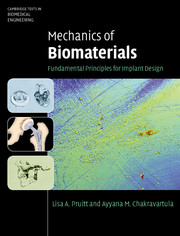Book contents
- Frontmatter
- Contents
- Symbols
- Prologue
- Part I Materials
- Part II Mechanics
- 6 Elasticity
- 7 Viscoelasticity
- 8 Failure theories
- 9 Fracture mechanics
- 10 Fatigue
- 11 Friction, lubrication, and wear
- Part III Case studies
- Epilogue
- Appendix A Selected topics from mechanics of materials
- Appendix B Table of material properties of engineering biomaterials and tissues
- Appendix C Teaching methodologies in biomaterials
- Glossary
- Index
- References
8 - Failure theories
from Part II - Mechanics
Published online by Cambridge University Press: 05 June 2012
- Frontmatter
- Contents
- Symbols
- Prologue
- Part I Materials
- Part II Mechanics
- 6 Elasticity
- 7 Viscoelasticity
- 8 Failure theories
- 9 Fracture mechanics
- 10 Fatigue
- 11 Friction, lubrication, and wear
- Part III Case studies
- Epilogue
- Appendix A Selected topics from mechanics of materials
- Appendix B Table of material properties of engineering biomaterials and tissues
- Appendix C Teaching methodologies in biomaterials
- Glossary
- Index
- References
Summary
Inquiry
How would you safely design a tibial insert of a total knee replacement that is known to experience a complex loading state with a normal stress component that is on the order of the uniaxial strength for this material?
The inquiry posed above represents a realistic design challenge that one might face in the field of orthopedics. Many of the tibial components used in total knee arthroplasty utilize ultra-high molecular weight polyethylene with a uniaxial yield stress on the order of 20 MPa; yet, the contact pressures for many of the clinical designs exceed this value. In order to assess the likelihood for failure owing to yield or plastic deformation, it is important to calculate the effective stress that provides a scalar representation of the multiaxial stress state acting on the implant. It is the effective stress that must be compared to the uniaxial yield strength as an assessment for the factor of safety against failure. Furthermore, localized plastic damage due to the presence of a notch or stress concentration can serve as a nucleation site for cracks if the component undergoes cyclic loading conditions. All of these factors must be considered when designing the implant.
Overview
The process of material failure depends upon the stress state of the system as well as whether its microstructure renders it ductile, brittle, or semi-brittle. In general, ductile materials yield before fracture while brittle materials fracture before yield. A semi-brittle system offers a small amount of plastic or permanent deformation prior to fracture. In the broad spectrum of materials behavior, metals are generally considered strong, tough, and ductile; ceramics are known to be strong in compression but weak in tension, and are notoriously brittle; and polymers are usually compliant, resilient, and highly sensitive to strain rate. Composites and tissues are typically anisotropic and are highly dependent upon the distribution of constituents. The most commonly employed mechanical test for material characterization is the uniaxial tensile test, which provides several important material properties including elastic modulus, yield strength, ultimate tensile strength, fracture stress, energetic toughness, and ductility (as shown in Figure 8.1).
- Type
- Chapter
- Information
- Mechanics of BiomaterialsFundamental Principles for Implant Design, pp. 241 - 282Publisher: Cambridge University PressPrint publication year: 2011



